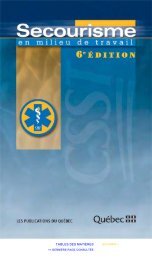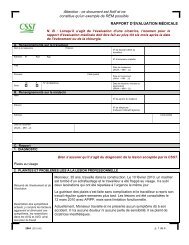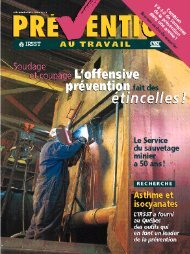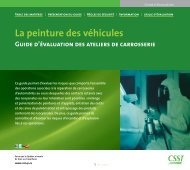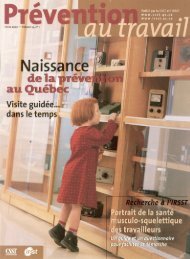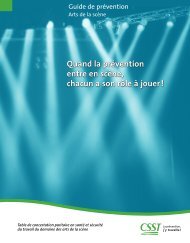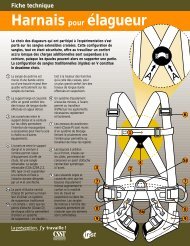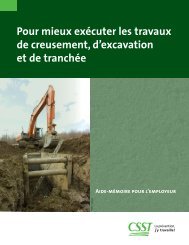MATERIAL SAFETY DATA SHEET USER'S GUIDE - CSST
MATERIAL SAFETY DATA SHEET USER'S GUIDE - CSST
MATERIAL SAFETY DATA SHEET USER'S GUIDE - CSST
Create successful ePaper yourself
Turn your PDF publications into a flip-book with our unique Google optimized e-Paper software.
materialsafetydata sheetuser’s guide
materialsafetydata sheetuser’s guide
WritingMichel GagnéAnne-Marie FilionJohanne DumontService du répertoire toxicologique, <strong>CSST</strong>Electronic publishingDanielle Gauthier and Chantal Grandmont, <strong>CSST</strong>IllustrationsRonald Du ReposProductionDirection des communications, <strong>CSST</strong>© Commission de la santé et de lasécurité du travail du QuébecLegal deposit – Bibliothèque nationale du Québec, 2002ISBN 978-2-550-39961-2
Table of contentsIntroductionWHMIS – Workplace Hazardous 5Materials Information SystemMaterial safety data sheet (MSDS) 6Information to disclose on the material 7safety data sheetProduct information 8Preparation information 9Hazardous ingredients 9Chemical name and ingredient concentration 9CAS registry number 10Lethal dose 50 (LD 50) 10Lethal concentration 50 (LC 50) 10Physical data 12Molecular formula* 12Molecular weight* 12Physical state 13Appearance 13Colour and odour 14Odour threshold 14Density 15Freezing point 15Melting point* 15Boiling point 16Vapour pressure 16Concentration at saturation* 17Vapour density 18Evaporation rate 19Cœfficient of water/oil distribution 20pH 21Solubility in water at saturation* 21Particle size* 22Fire or explosion hazard 24Flash point and method of determination 24Lower and upper explosive or flammable limits 26Auto-ignition temperature 28Conditions of flammability 28Explosion conditions* 29Explosion data – sensitivity to mechanical impact 29Explosion data – sensitivity to static discharge 29Means of extinction 30Special precautions* 30Hazardous combustion products 30*Non-essential information for WHMIS purposes
Reactivity data 31Conditions of chemical instability 31Name or class of substances with which 32the product is incompatibleConditions of reactivity 32Hazardous decomposition products 33Polymerization* 33Toxicological properties 34Routes of entry, skin and eye contact 34Effects of acute exposure to product 36Effects of chronic exposure to product 38Exposure limits 40Irritancy and corrosiveness 41Sensitization to product 42Carcinogenicity 42Reproductive toxicity 44Teratogenicity 44Mutagenicity 46Names of toxicologically synergistic products 48Preventive measures 49Protective equipment to be used 49Engineering controls to be used 50Procedures to be followed in case of leak or spill 51Waste disposal 52Handling procedures and equipment 52Storage requirements 54Special shipping information 54First aid measures 56Regulations 57Workplace Hazardous Materials 57Information System (WHMIS)Disclosure list 58Regulation respecting occupational 59health and safety (ROHS)Transportation of Dangerous Goods (TDG) 60Glossary 62Measurement units 79Conversion factors 80Services offered 81Example of a Material safety data sheet 83*Non-essential information for WHMIS purposes
IntroductionThe role of the Service du répertoire toxicologiqueof the Commission de la santé et dela sécurité du travail (<strong>CSST</strong>) is to inform Québecemployers and workers of the health and safety hazardsof chemical or biological substances used in theworkplace.The purpose of this guide is to facilitate theunderstanding and use of the information providedon a material safety data sheet by defining, forexample, a product’s properties and by showing howto use the MSDS for prevention. A glossary of themain terms used in material safety data sheets, themeasurement units, and the conversion factors mostfrequently used are also presented in the appendix.WHMISWorkplace Hazardous MaterialsInformation SystemWHMIS is a Canada-wide system for protecting thehealth and safety of workers by facilitating access toinformation on the hazardous materials used in theworkplace. This system consists of three parts, namelymaterial safety data sheets, labels and the workertraining program.For more information on WHMIS, consult theRegulations section of this guide.
Material safety data sheet(MSDS)A material safety data sheet is a document that providesinformation on a controlled product, namely itstoxic effects, the protective measuresfor avoiding overexposure or chemical hazards,and the procedures to follow in an emergency.A controlled product is a hazardous materialmeeting the hazard criteria defined in the ControlledProducts Regulations. The information provided onthe MSDS completes the information that is foundon the label of a controlled product. The suppliersends the MSDS to the employer when the productis sold. It must be available in French and in English,be kept on the premises by the employer in a locationknown by the workers, and be easily and rapidlyaccessible to those who are likely to come in contactwith the product.6
Information to disclose on the materialsafety data sheetThe material safety data sheet must contain nine categoriesof information. They can be presented underthe following headings or under equivalent headings.• Product information• Information on the preparation of the MSDS• Hazardous ingredients• Physical data• Fire and explosion hazards• Reactivity data• Toxicological properties• Preventive measures• First aid measuresThe internationally harmonized material safetydata sheet, consisting of 16 categories of information,is accepted in Canada insofar as it contains theinformation required by WHMIS and that it mentionsthat the product has been classified in accordancewith the hazard criteria listed in the ControlledProducts Regulations.7
Product informationThis section of the MSDS includes the following:• Product identifier/name.• Manufacturer’s name, street address, city, province,postal code and emergency telephone number.• Supplier identifier/name, street address, city, province,postal code and emergency telephone number,if it is different from that of the manufacturer.• Product use.The product’s name indicated on the MSDS must beidentical to the name written on the label.ExampleMaterial safety data sheetProduct identifier/name :Toluène/TolueneManufacturer’s identifier/name :Produits chimiques ABC inc.1234, rue ABCMontréal (Québec) Z0Z 0Z0Emergency telephone no. : 1 800 123-4567Supplier’s identifier/name :Distributions XYZ123, rue XYZQuébec (Québec) X0X 0X0Emergency telephone no. : 1 800 987-6543Product use : Paint solventLabel :8
Preparation informationThis section of the MSDS includes the following:• Name and telephone number of the group, departmentor party responsible for thepreparation of the material safety data sheet.• Date of preparation of the material safety datasheet.The material safety data sheet must be revised atleast every three years or as soon as new pertinentinformation becomes available.Hazardous ingredientsThis section of the MSDS includes the following:Chemical name and concentrationof ingredients,i) which are controlled products if they are presentat a concentration equal to orgreater than 0.1% in the mixture (applies toingredients that are teratogenic, embryotoxic,carcinogenic, toxic to reproduction,mutagenic and respiratory tract sensitizers). Inother cases, ingredients that arethemselves controlled products and whoseconcentration is above 1% are disclosed;ii) which are on the ingredient disclosure list,if their concentration is equal to or greaterthan the concentration on this list (even ifthe ingredient is not a controlled product asdefined in WHMIS);iii) which the supplier believes, based onreasonable grounds, to be harmful to thehealth of the workers;iv) whose toxicological properties areunknown.9
The concentration is defined as being the amount ofa component in the total amount of the mixture. Itcan be expressed as a percentage (%) and interpretedas being a ratio:• Weight of component/weight of mixture (W/W), or• Weight of component/volume of mixture (W/V), or• Volume of component/volume of mixture (V/V).On the MSDS, the actual concentration of theingredient can be replaced by one of the followingpermitted ranges of concentrations, namely:• from 0.1 to 1% • from 10 to 30%• from 0.5 to 1.5% • from 15 to 40%• from 1 to 5% • from 30 to 60%• from 3 to 7% • from 40 to 70%• from 5 to 10% • from 60 to 100%• from 7 to 13%CAS registry numberThe CAS number is assigned by the Chemical AbstractsService, a division of the American Chemical Society, toprecisely identify a chemical substance.Lethal dose 50 (LD 50)This is the amount of a substance that causes thedeath of 50% of the laboratory animals exposedto it orally (ingestion) or cutaneously. There areother routes of entry (for example by injection), butWHMIS does not take them into account.Lethal concentration 50 (LC 50)This is the concentration of a substance in theair that causes the death of 50% of the laboratoryanimals exposed to it by inhalation, generally for4 hours.10
ExamplesPure product:Hazardous ingredient CAS concentration LD 50LC 50Ammonia 7664-41-7 60-100% Rat: 2,000 ppm/4 hProduct composed of several ingredients:Hazardous ingredients CAS concentration LD 50LC 50Methyl yellow 60-17-7 0.1-1% Rat, oral:200 mg/kgMouse, oral:300 mg/kgEthylene glycol 107-21-1 60-100% Rat, oral:4.7 g/kgMouse, oral:7.5 g/kgRabbit, skin:9.5 g/kg11
Physical dataThis section of the MSDS describes the physicochemicalcharacteristics of a substance based on currentscientific knowledge.Molecular formulaThe molecular formula describes, using theirsymbols, the elements that make up a substance, andindicates their proportion. Pure substances are theonly ones with a definite molecular formula.ExamplesWater : H 2O, Toluene : C 7H 8Molecularformula?Water H 2OToluene C 7H 8Molecular weightThis is the weight in grams of a fixed quantityof molecules of a chemical product. The molecularweight is defined only for pure chemicalsubstances.ExampleToluene : 92.15 g12
Physical stateThis is the form or state in which the product ispresent: gas, liquid or solid at ambient temperature(20°C) and at normal atmospheric pressure(760 mm Hg (101.32 kPa)).ExampleSolid : limeLiquid : waterGas : oxygenSolid Liquid GasAppearanceThis subsection provides specific informationon the product or presents additional informationon the product’s physical state or appearance.ExamplesIf the product is solid, it can be crystalline,granular, powdery, etc.If it is liquid, it can be viscous, gelatinous, oily, etc.crystallinesolidgranulatedliquidviscousgELaTInous13
Colour and odourThese are some of the product’s physical characteristics.A product can have a specific colour orbe colourless. It may have a characteristic anddistinctive odour or be odourless. The odour of someproducts may be detected, starting at a certain concentration,namely the odour threshold.ExamplesColour :• gray: copper sulfate• colourless: waterOdour :• aromatic: toluene• characteristic: chloroformOdour thresholdThis is the minimum concentration of a substancelikely to be detected in the air by human smell.It is usually expressed in parts per million (ppm).ExampleAmmonia can be detected at 17 ppm.1 ppm 8 ppm 17 ppm14
DensityDensity is a physicochemical property relatedto the weight of a substance. It represents the weightof a substance per unit volume and is expressed ingrams per millilitre (g/ml) at 20°C. Specific gravityis also a physicochemical property that is commonlyused instead of density. However, it is a relativevalue that indicates how many times heavier thanwater the product is. If the density of a product thatis rather insoluble in water is less than 1 g/ml, theproduct will float. However, if itis greater than 1 g/ml, the product will sink. Thisinformation is useful in predicting the behaviour of aproduct in the event of a leak or accident.ExampleToluene is not very soluble in water. Its density is0.8661 g/ml, therefore less than 1, so it floats onwater.Freezing pointThis is the temperature at which a substance goesfrom the liquid state to the solid state at normalatmospheric pressure (760 mm Hg (101.32 kPa)).The freezing point of a pure substance is the same asits melting point.ExampleWater crystallizes at 0°C.Melting pointThis is the temperature at which a substance goesfrom the solid state to the liquid state at normalatmospheric pressure (760 mm Hg (101.32 kPa)).ExampleIce melts at 0°C.15
Boiling pointThis is the temperature at which a substance goesfrom the liquid state to the gaseous state at normalatmospheric pressure (760 mm Hg (101.32 kPa)).ExampleWater boils at 100°C.Vapouricewater0ºCMELTINGFREEZING100ºCBOILINGVapour pressureWhen a substance evaporates, its vapours exert pressurein the ambient environment. Vapour pressure isexpressed in millimetres of mercury (mm Hg) or inkilopascals (kPa) at 20°C and normalatmospheric pressure of 760 mm Hg (101.32 kPa).A vapour pressure greater than 760 mm Hg(101.32 kPa) indicates that the substance is inthe gaseous state. The higher a substance’s vapourpressure, the more it tends to evaporate.16
ExampleThe vapour pressure of water is 17.5 mm Hg(2.33 kPa) and that of diethyl ether, 439.8 mm Hg(58.63 kPa). Therefore, diethyl ether evaporatesfaster than water.Diethyl ether: 439.8 mm HgWater: 17.5 mm HgConcentration at saturationThis is the maximum concentration that a substancecan reach in the air at equilibrium, 20°Cand normal atmospheric pressure of 760 mm Hg(101.32 kPa).ExampleToluene has a concentration at saturation of28,800 ppm.17
Vapour densityThis information indicates how many times thevapours of a substance are heavier or lighter than air(air = 1). This measurement is taken at theboiling point.If the vapour density is greater than 1, a substance’svapours will tend to remain near the ground.Examples• Toluene has a vapour density of 3.18. Therefore, atits boiling point, its vapours will tend to remain atthe ground.• Methyl alcohol has a vapour density of 1.1.Therefore at its boiling point, its vapours willmix easily with air, since its vapour density is closeto 1.Vapourdensity3.18TolueneMethyl alcoholVapourdensity1.1Note. – The behaviour of vapours is valid only fora rather short period of time and at a temperatureclose to the boiling point. The vapours given off by aboiling substance disperse into the air over time. Thetendency of vapours to remain close to the grounddecreases as the difference between the ambient temperatureand the boiling pointincreases.18
Evaporation rateThe evaporation rate indicates the relationshipbetween the time that a product takes to evaporateand the time that a reference product takes to evaporate.It indicates, at equal volume, how many timeslonger a product takes to evaporate than another.The rate varies with the type of product and the temperature.Diethyl ether, for example, is the referenceproduct on which the most data is available.ExampleToluene’s evaporation rate is 4.5 in relation to thatof diethyl ether. Therefore, toluene takes 4.5 timeslonger than diethyl ether to evaporate.Diethyl ether: 1 Toluene: 4.5Note. – There are other reference products, such asn-butyl acetate, which are used to establish an evaporationrate. There are also other ways of establishingthe evaporation rate. One of the methods used consistsof determining, for the same period, the ratioof the volumes of the target product and referenceproduct that evaporated. Another method consistsof determining, for the same initial volume of liquid,the ratio of the percentages of the target product andreference product that evaporated. Unfortunately,sometimes a value is givenwithout the method used being indicated.19
Coefficient of water/oil distributionThis is the ratio of the solubility of a product in oilto its solubility in water when they are brought intocontact with the product.A value below 1 indicates a better solubility of theproduct in oils and greases. The product is thereforelikely to be absorbed by the skin. However, a valuegreater than 1 indicates a better solubility in water.This product could therefore be absorbed by themucous membranes. This information can be usefulin evaluating the first aid to be given and can facilitatethe choice of protective equipment.ExampleToluene has a coefficient of water/oil distribution of0.0026. Therefore, toluene is more soluble in oil thanin water with a value of 0.0026 g in water to 1 g inoil.Note. – On some material safety data sheets, thedistribution coefficient is expressed as log Pow,therefore as the logarithm of the n-octanol/waterpartition coefficient. n-Octanol is in fact the referencesubstance that is closest to oil. The method forconverting log Pow into the coefficient of water/oildistribution is described in the Conversion factors sectionof this guide.20
Particle sizeThe particle size indicates the size of the particlesforming a powder, a dust, a mist, an aerosol or fumes.Particles smaller than 1µm* can penetrate deeplyinto the respiratory tract and deposit in the alveoli.Slightly larger particles (from 1 to 5 µm) reach thetrachea, bronchi and bronchioles. Larger particles(from 5 to 30 µm) reach the nose and pharynx region.Even larger particles (larger than30 µm) rarely penetrate the upper respiratory tract.Depending on the substance, they may dissolve andbe absorbed by the body. Therefore, by knowing thesize of the particles of a substance, one can decide onthe corrective measures to adopt to reduce or eliminatethe hazard at source (for example, by planningfor local ventilation). If it is impossible to reduce oreliminate the hazard at source, knowledge of the particlesize will make it easier to choose the respiratoryprotection device.* 1 µm (micron) represents 10 -6 metres (0.000001 metre) or10 -3 millimetres (0.001 mm). For example, 1 µm is approximately1,000 times smaller than a grain of sand.22
Less than 1 µm 1 to 5 µm5 to 30 µm More than 30 µm23
Fire or explosion hazardFlash point and method of determinationThe flash point is the lowest temperature at which asubstance gives off sufficient vapours to form a flammablemixture with the air on contact with a flameor spark. A product’s flash point is determined byeither of the two following methods: in a closed cup,meaning inside the container that contains it, or inan open cup, meaning near the surface of the liquid.The lower a liquid’s flash point, the greater the riskof fire.ExampleNormal butanol has a flash point in a closed cup of29°C (Set-a-flash method). It is therefore extremelyflammable on a hot summer day when its vapourscome in contact with a flame or spark.24
20˚C25˚C29˚C25
Lower and upper explosive orflammable limitsThese are the minimum and maximum concentrationsof a product in the air between which aflammable or explosive mixture can form in the presenceof an ignition source. These concentrations areexpressed as a percentage of the volume in the air.ExampleEthylene has a lower explosive limit of 2.7% and anupper limit of 36%. Therefore, in the presence ofan ignition source, if the concentration of the gas isless than 2.7% or greater than 36%, there is no riskof explosion. But if the concentration of the substanceis between these two limits, the mixture couldexplode. The concentration of the product in theair must be kept under its lower explosive limit, forexample by using appropriate ventilation.26
1%1.5%2.7%27
Auto-ignition temperatureThis is the lowest temperature at which spontaneouscombustion of a product occurs. It begins to burn byitself in the absence of any flame or spark. The closerthe auto-ignition temperature is to the ambient temperature,the greater the risk of fire.ExampleTurpentine has an auto-ignition temperature of253°C. Therefore, it will not burst into flame by itselfat ambient temperature.253ºC200ºC50ºCConditions of flammabilityConditions of flammability indicate whether aproduct could burst into flame and under whatconditions.ExampleToluene is a flammable liquid and will therefore burstinto flame if it is near a source of ignition.Note. – When a substance is classified “flammable”,the necessary precautions must be taken to avoid itreaching its auto-ignition temperature or its flashpoint, depending on the case.28
Explosion conditionsExplosion conditions indicate whether a product islikely or not to explode when it is used.ExampleToluene vapours form an explosive mixture with air.Explosion data — sensitivity tomechanical impactThese data indicate whether or not there is a risk ofexplosion on impact, and if so, specify under whatconditions the explosion could occur.ExamplePicric acid may explode on impact.Explosion data — sensitivity to staticdischargeThese data indicate whether or not there is a risk ofexplosion with a static discharge, and if so, underwhat conditions explosion could occur.ExampleWhen xylene is shaken or when it flows in pipes, itcan accumulate a static charge that may cause thevapours to ignite.29
Means of extinctionThis subsection contains a list of the extinguishingagents to use to fight a fire when this product is presentor when it is the cause of the fire.ExampleToluene : Carbon dioxide, dry chemical, water spray,alcohol foam.Special precautionsThis subsection describes the special precautions totake to fight a fire when this product is present orwhen it is the cause of the fire. Also indicated arethe specific means for avoiding an explosion or thepropagation of the fire.ExampleToluene : Wear a self-contained breathing apparatus.The vapours are heavier than air and can travela great distance towards a source of ignition and thuscause flashback.Hazardous combustion productsThis subsection lists the combustion products thatare health and safety hazards and that may formwhen the substance burns.ExampleToluene : Carbon dioxide, carbon monoxide.30
Reactivity dataConditions of chemical instabilityThis information indicates whether a substance isstable and, if need be, indicates the conditions thatproduce chemical instability.ExampleSodium hypochlorite gives off toxic fumes ofchlorine when it is heated. Appropriate ventilationmust be provided to ensure that the permissible limitvalues are not exceeded.31
Name or class of substances with whichthe product is incompatibleThis subsection indicates whether a product mustnot be brought into contact with certain specifiedsubstances, and if need be, specifies the nature of thehazard if the product is brought into contact withthese substances.Example12% bleach is incompatible with strong acids. Oncontact, it gives off toxic chlorine vapours.Conditions of reactivityThis indicates whether a substance is likely toreact violently or dangerously under normal conditionsof use. If need be, the nature of the hazard isspecified.Example12% bleach is unstable in the presence of light andmetals or when the pH of the solution becomes lessbasic.32
Hazardous decomposition productsThis subsection lists the products that are health andsafety hazards that are likely to form when a substancedecomposes. Decomposition may be the resultof a reaction occurring at room temperature, exposureto light, or the effect of heat on the substance,etc.ExampleAmmonia: thermal decomposition (begins between450°C and 500°C), giving off nitrogen and hydrogen.PolymerizationThis subsection indicates whether the substancecan change into a polymer (the combining of severalmolecules) and under what conditions this changeoccurs. The heat given off and/or the expansion involume caused by the polymerization reaction couldcause the container to burst and the remaining product(unpolymerized) to spill. These accidents can beavoided by controlling the polymerization conditions.ExampleExposure to light or contact with strong acids orbases can cause acrolein to polymerize.33
Toxicological propertiesRoutes of entry, skin and eye contactThis section indicates the routes by which the substancecan enter the body and produce harmfuleffects. These routes include the respiratory tract(inhalation), skin (cutaneous absorption) and thedigestive tract (ingestion). Also included is anysurface of the body on which the substance can producea harmful effect by direct contact.ExamplesRoutes of entryToluene : The substance is absorbed through therespiratory tract, skin and digestive tract.Skin and eye contactSulfuric acid : Following direct contact with the skinand eyes, this product may cause burns.34
Respiratory tractDigestive tractSkin35
Effects of acute exposure to productThese health hazards result from short-termexposure to the controlled product. Acute exposureis generally defined as a single or repeated exposureover a 24-hour period. Often, acute poisoning producesbrief and reversible toxic effects. However,some effects may show up only several hours afterintoxication. Also, some serious poisonings may producesequellae.ExampleExposure to high concentrations of acetone vapours(above 12,000 ppm) may cause dryness of the mouthand throat, salivation, anorexia, headache, nausea,vomiting, dizziness, incoordination, asthenia, lethargyand ataxia. In extreme cases, it can lead to stuporor coma.36
Effects of chronic exposure to productThese health hazards result from prolongedexposure to the controlled product at concentrationslower than those that produce acute effects. Theduration of the exposure can vary (weeks, months,years).ExampleThe repeated inhalation of styrene vapour may causenervous system disorders that first appearas headache, nausea, dizziness, a loss of appetite, andgeneral weakness. The following effects may subsequentlybe observed: increased reaction time, difficultywith colour perception, etc. Repeated skin contactwith the product may cause redness, desquamationand cracking of the skin.38
MONDAYTUESDAYWEDNESDAYTHURSDAYFRIDAY1 st week2 nd week3 rd week4 th week39
Exposure limitsExposure limits are the concentrations permittedin the air for a given substance. They represent theconcentrations of the substance in the air to whichthe great majority of workers can be exposed daily,without suffering harmful effects. There are threetypes of values:• Short-term exposure values, which are measuredfor a maximum duration of 15 minutes;• Time-weighted average exposure values, which aremeasured for the duration of an 8-hour work shift;• Ceiling values, which must never be exceeded forany period of time whatsoever.On the material safety data sheet, the permissiblelimit values in Québec, which are specified by theRegulation respecting occupational health and safety(S-2.1, R.19), are sometimes presented. For moredetails, consult the Regulations (ROHS) section ofthis guide. However, the limit values recommendedby the ACGIH® (American Conference of GovernmentalIndustrial Hygienists), an American organization, areoften the ones that appear onthe MSDS. Exposure limit values are given in ppm, inmg/m 3 or in fibres/cm 3 .If a product consists of several ingredients, the exposurelimit for each of the ingredients must be indicatedon the MSDS.40
Irritancy and corrosivenessThis subsection indicates whether the substance maycause irritation of the eyes, skin or mucous membranesof the respiratory and digestive tracts.A substance’s irritating effects on the eyes or skinmay be, for example, a minor tingling sensation toerythema (redness) or edema (swelling). This damageis reversible, meaning that it disappears with time,when exposure to the product stops. If the damagecaused by a substance is irreversible, the substanceis said to be corrosive.ExamplesIsopropyl alcohol is moderately irritating to the eyesand slightly or not irritating to the skin. Exposure tovapours of this substance may cause irritation of theeyes and upper respiratory tract.Sodium hydroxide is a corrosive product that maycause serious burns accompanied by deep ulcerationof the skin. On the eyes, it causes disintegration andescharification of the conjunctiva and cornea accompaniedby edema and ulceration. Permanent opacificationof the cornea is also possible. Expo-sure todusts or mists may cause irritation and ulceration ofthe nasal passages. Pulmonary edema may occur withexposures to high concentrations of dusts or mists.41
Sensitization to productSensitization is an immune reaction of the body.It occurs following exposure to a chemical or biologicalsubstance and produces an allergic response ofthe respiratory tract (rhinitis, asthma) or skin (eczema).Exposure to the sensitizing substance may havepreviously produced no symptoms, until an initialallergic response occurs.ExamplesAfter an initial contact with isocyanates (TDI, HDI,MDI, etc.), subsequent contact may produce sensitizationof the respiratory tract (asthma) in somepeople.Formaldehyde (used as a preservative in varioustypes of products such as cutting oils) is a skin sensitizer.CarcinogenicityThis subsection specifies whether the substancecan cause cancer or not. WHMIS uses the IARC(International Agency for Research on Cancer) andACGIH® (American Conference of GovernmentalIndustrial Hygienists) classifications to determine asubstance’s carcinogenic potential. A substance classifiedA1 and A2 by the ACGIH, or group 1, 2A and2B by IARC, is recognized as carcinogenic by WHMIS.Substances can be listed as proven, probable or possiblecarcinogens, depending on the evidence observed.ExampleThe International Agency for Research on Cancer (IARC)considers styrene as a possible human carcinogen(group 2B).42
0 to 5 years5 to 10 years10 to 15 years43
Reproductive toxicitySome substances can have toxic effects on reproduction,meaning that they can cause a change in fertility,thus affecting a woman’s or a man’s reproductivecapability. For example, some substances may affecthormonal activity, spermatogenesis, etc., which mayaffect fertility.ExampleCarbon disulfide may cause sperm disorders as wellas menstrual disorders in humans.TeratogenicityThis section states whether the substance can causemalformations in newborns. The Controlled ProductsRegulations require that all effects on development bementioned, and therefore embryotoxic andfetotoxic effects (effects other than malformations)must appear on the MSDS. These may include,for example, a reduction in body weight, growthretardation, dysfunction, death, etc. Effects on postnataldevelopment (after birth) are also indicated.Most of the time, the information comes from animalstudies.44
ExampleToluene has an embryotoxic and/or fetotoxic effecton animals.45
MutagenicityThis subsection indicates whether the substance maycause mutations (changes) in the genetic material(DNA) of cells. Mutations in the DNA of reproductiveor germ cells (eggs or sperm) may cause hereditaryeffects, meaning that they are transmissible to offspring.Effects on other cells (nonreproductive orsomatic cells) do not cause hereditary effects, butmay lead to cell death, the transmission of the mutationto cells of the same tissue, or cancer.ExampleBenzene is a human mutagen.46
Exposure toradioactivity= mutageniceffectEFFECT= transmissionof the effetcs tofuture childrenEFFECT47
Names of toxicologically synergisticproductsThese are substances or products that interact withthe controlled product to produce a toxic effect greaterthan the sum of their individual effects.There are other types of interactions betweenchemical products, namely antagonism (reduced toxiceffects), the additive effect (effects that are added),etc. However, the Controlled Products Regulations donot require that these effects be mentioned on theMSDS.ExampleThe duration of xylene’s toxic effects increases withthe consumption of alcohol or aspirin.XyleneAlcohol48
Preventive measuresThis section contains useful information forprotecting the health and physical well-being ofa worker exposed to the product under normal oraccidental conditions of use, handling, or storage ofthis product.Protective equipment to be usedThis subsection specifies the parts of the body tobe protected and the type of protective equipmentappropriate to the contaminant exposure and theregulations in force in Québec. For more informationon the respiratory protective equipment to usein Québec, consult the following Web site: www.prot.resp.csst.qc.ca.ExampleXyleneRespiratory tractFrom 100 ppm, wear an appropriate respirator.SkinGloves: Multilayer polyethylene/ethylene vinylalcohol/polyethylene (PE/EVAL/PE), polyvinyl alcohol(PVAL), multilayer Viton®/butyl rubber/Viton® orViton®.EyesWear safety glasses if there is a risk of splashing.49
Engineering controls to be usedThis subsection contains the specific procedures toapply to handle the product safely.ExampleXyleneThis flammable liquid must be handled in compliancewith the Flammable and Combustible Liquids CodeNFPA 30. Use tools that will not produce sparks.Wear the appropriate protective clothing and ventilateadequately. Equipment must be grounded andbounded: refer to NFPA 77 code.hazard50
hazard51
Procedures to be followed in case ofleak or spillThis subsection contains procedures to apply in theevent of accidental leaks or spills of the product aswell as the means of disposing of it.ExampleTolueneIn the event of accidental leaks or minor spills,absorb with sand or any other non-combustibleabsorbent material. Place the mixture in a well-identifiedairtight container so that it can betreated later in compliance with the regulationsin force.52
hazard53
Waste disposalThe steps to be taken for product waste disposal areexplained in this subsection.ExampleXyleneVentilate the site of the spill well so that the remainderof the liquid evaporates and the vapours disperse.Do not pour the waste into the sewer and do notdispose of contaminated absorbents in the garbage. Ifnecessary, consult the regional office of the ministèrede l’Environnement. Dispose of it in compliance withthe municipal, provincial andfederal regulations in effect.Handling procedures and equipmentConsult the Handling subsection to learn how tohandle the product safely.ExampleAcetyleneCompressed gas cylinders must not be subjected toviolent impact, and a damaged cylinder must neverbe used. Do not use cylinders of compressed gas forpurposes other than those for which they are intended.They must be attached upright or secured in acart when they are used. Handle them away from allsources of heat and ignition. Use toolsthat will not produce sparks. Equipment must begrounded.54
hazard55
Storage requirementsThe Storage subsection contains the conditions forsafe storage of the product.ExampleXyleneStore it in a cool and well-ventilated location, awayfrom sources of heat and ignition and incompatiblesubstances. The containers must be grounded.Special shipping informationThe Shipping subsection contains the specialinformation relating to the shipping of dangerousgoods. For more details, consult the Regulationssection (TDG) of this guide.56
First aid measuresThis section of the MSDS describes the first aid to begiven in the event of poisoning or accidental contactwith the product.ExampleStyreneInhalationIn the event of inhalation of vapours, take the personto a ventilated location. If the person is not breathing,perform artificial respiration. Call a physician.Eye contactRinse the eyes with plenty of water for 15 to 20 minutes.If the irritation persists, consult a physician.Skin contactRapidly remove contaminated clothing. Wash skinwith soap and water.IngestionIn the event of ingestion, rinse the mouth withwater. If there are unusual symptoms, consult a physician.57
RegulationsWorkplace Hazardous MaterialsInformation System (WHMIS)In Québec, the <strong>CSST</strong> is responsible for applyingWHMIS according to the Regulation respectinginformation on controlled products (Québec regulation),the Controlled Products Regulations (federal regulation)and the Hazardous Products Act.WHMIS divides hazardous materials into six mainclasses. These classes are based on the hazard criterialisted in the Controlled Products Regulations. Acontrolled product is a substance that meets one ormore classification criteria. This classification can bebased on the data inherent in the material or data onits ingredients.ClassesA: Compressed gasB1: Flammable gasesB2: Flammable liquidsB3: Combustible liquidsB4: Flammable solidsB5: Flammable aerosolsB6: Reactive flammablematerialsC: Oxidizing material58
D1A: Very toxic materialcausing immediate andserious effectsD1B: Toxic material causingimmediate and seriouseffectsD2A: Very toxic materialcausing other effectsD2B: Toxic material causingother effectsD3: Biohazardous infectiousmaterialE: Corrosive materialF: Dangerously reactivematerialDisclosure listThis list specifies whether a substance is or is not onthe disclosure list of regulated ingredients accordingto the Hazardous Products Act and the cut-offconcentration at or above which it must be disclosed(namely 0.1% or 1.0%).ExampleAmmonia must be disclosed if its concentration in amixture is equal to or greater than 1.0% (W/W).59
Regulation respecting occupational healthand safety (ROHS)In Québec, the permissible exposure values for aircontaminants are those prescribed by the Regulationrespecting occupational health and safety (S2.1, R.19),extracts of which are presented below.The time-weighted average exposure value(TWAEV) “is the time-weighted average concentrationfor an 8-hour workday and a 40-hour workweekof a chemical substance (in the form of gases, dusts,fumes, vapours or mists) present in the air in a worker’srespiratory zone.”“For any work period equal to or longer than4 hours but less than 8 hours or a period in excessof 8 hours but less than or equal to 16 hours, anadjusted average exposure value (AAEV) mustbe established in accordance with the Guide to theadjustment of permissible exposure values for unusualwork schedules, published by the Institut de rechercheRobert-Sauvé en santé et en sécurité du travail (www.irsst.qc.ca), as it reads at the time it is applied. Underno circumstance may the AAEV be higher than theTWAEV.”The short-term exposure value (STEV) “is the15-minute time-weighted average concentration forexposure to a chemical substance (in the form ofgases, dusts, fumes, vapours or mists), present in theair in a worker’s respiratory zone which should notbe exceeded at any time during a workday, even if thetime-weighted average exposure value is not exceeded.The average exposure for a 15-minute consecutiveperiod may be included between the TWAEV and theSTEV, insofar as such exposures are not repeatedmore than 4 times a day and have intervals betweenthem of periods of at least 60 minutes.”60
The ceiling value “is the concentration never to beexceeded during any length of time whatsoever.”The regulation also includes designations andremarks: Pc (percutaneous), EM (exposure reducedto a minimum), RP (recirculation prohibited), S (sensitization)and the carcinogen designations.For more details, consult Schedule 1 of the Regulationrespecting occupational health and safety.Transportation of dangerousgoods (TDG)In Québec, the TDG is regulated by the Transportationof Dangerous Substances Regulation of the ministèredes Transports of Québec. It was adopted in compliancewith the Transportation of Dangerous GoodsRegulations of Transport Canada, in application of theTransportation of Dangerous Goods Act.DefinitionsPIN (UN) : Product Identification Number. Numericor alphanumeric designation used to identify a substanceor a group of substances with the same nameas dangerous goods in the regulation.Class : numeric data used to designate a substanceaccording to the characteristics of the hazard. In theTransportation of Dangerous Goods Act, products aredivided into nine classes. A substance can be assignedmore than one class, with the primary class (describingthe main hazard) and the subsidiary class orclasses also indicated.Packing group or risk group : numerical designationin Roman or Arabic numerals used to indicate, asapplicable, the hazard or risk level of goods.61
Special provisions : numerical designation referringto a section of Schedule 2 of the Transportationof Dangerous Goods Regulations and defining, as applicable,the special measures applying to the meansof containment, handling, offering for transport ortransportation of a dangerous good.Explosive limit and limited quantity index :number indicating the maximum amount of the hazardousgood that may be handled or transported, orwhose transport can be requested.ERAP index : number indicating the maximumamounts related to ERAP (Emergency ResponseAssistance Plans), beyond which the dangerous goodsare subject to the provisions of ERAP.Passenger-carrying ship index : number indicating“the maximum quantity of dangerous goods per consignmentthat can be carried in a passenger carryingship”.Passenger-carrying road vehicle or passengercarryingrailway vehicle index : number indicating“the maximum quantity of dangerous goods thatcan be transported per consignment on a passengercarrying road vehicle or a passenger carrying railwayvehicle”.Marine pollutant : notation classifying a dangerousgood as “P” (marine pollutant), as “PP” (severe marinepollutant) or “.” (potential marine pollutant).62
AGlossaryAAEVAdjusted average exposure value according to theGuide to the adjustment of permissible exposure valuesfor unusual work schedules, published by the Institutde recherche Robert-Sauvé en santé et en sécurité dutravail.AbsorptionPassing of a substance from outside to inside thebody. Absorption pathways are routes by which asubstance enters the body without injury. The usualroutes in the workplace are the respiratory tract (byinhalation) and skin (cutaneous penetration). Thedigestive tract (ingestion) is the least common.ACGIH®American Conference of Governmental IndustrialHygienists. Non-governmental American organizationof industrial hygienists from governmental agencies.The ACGIH® develops and publishes recommendedexposure standards for chemicals and physical agentsas well as a list of biological exposure indices.AcidA chemical substance that can release a hydrogenion (H + ). Acidity is measured in pH units from 0 to7, where 7 is neutral and 0 very acid. According toWHMIS, a substance is a corrosive material if its pHis equal to or less than 2, when precise data are lacking.Active (or reactive) metalsMetals that react easily and rapidly with water, acidsor alkalis (examples: sodium, aluminum and zinc).AlkalisCarbonates, hydroxides, silicates, etc., of alkali metals(examples: sodium hydroxide, potassium hydroxide,etc.). Alkalis are basic and often corrosive substances.63
AlopeciaTotal or partial loss of hair, usually temporary.AnemiaReduction in the number of red blood cells or theamount of hemoglobin per unit volume of blood.AnhydrousEnvironment that does not contain any water, asopposed to humid, or a substance that does not containwater, as opposed to hydrated.AnorexiaReduction or loss of appetite.AnoxiaReduction in the amount of oxygen carried by theblood into the tissues.AnuriaAbsence of urine in the bladder.ApathyAbsence of feeling with indifference to outside stimuli.ApneaTransient cessation of breathing.ArgyriaPoisoning by silver and its salts.ArrhythmiaDisturbance in the heart rate.AsphyxiaDifficult breathing or respiratory arrest.AstheniaReduction or loss of strength (physical and psychic).AsthmaRespiratory illness caused by an inflammatory reactionof the bronchi with symptoms such as difficultbreathing, cough and wheezing.AtaxiaIncoordination of movements.AtrophyReduction in the weight and volume of an organ, tissueor cells.64
B BaseA chemical substance that can release a hydroxide ion(OH - ). Basicity is measured in pH units from7 to 14, where 7 is neutral and 14 very basic.According to WHMIS, a substance is a corrosive materialif its pH is equal to or greater than 11.5, whenprecise data are lacking.Biological exposure indices (BEI®)Numerical value used to evaluate the amount of asubstance absorbed by the body. The substance orone of its metabolites is measured in a tissue, a biologicalliquid or in the expired air. This designation ispublished by the ACGIH®. The French equivalent isIBE (Indices biologiques d’exposition).Biological monitoringPeriodic monitoring of one or more biological media(blood, urine, etc.) in order to determine the absorptionof a contaminant following exposure.BlindnessLoss of sight.Blood lead concentrationAmount of lead in the blood.Bond, ToTo connect all conductive components in an electricalinstallation together.BradycardiaSlowing of the heart rate.BronchitisInflammation of the bronchi.BronchoconstrictionContraction with narrowing of the bronchi.BronchospasmSpasmodic contraction of the muscles surroundingthe bronchi.ByssinosisPulmonary disorder due to the chronic inhalation ofcotton dust.65
CCarcinogenic (Effect)Indicates that the product may cause cancer.CAS numberNumber assigned by the Chemical Abstracts Service, adivision of the American Chemical Society, to identifya chemical substance. It is recognized by the characteristicpresence of two dashes always located at thesame place. Example: 12345-67-8.Central nervous system (CNS)System consisting of the brain and spinal column.The effects of contaminants on the CNS can be thefollowing: headache, nausea, vomiting, dizziness,incoordination, drowsiness, anesthesia, convulsions,etc.CephalgiaHeadache.Characteristics of an exposureDefines or characterizes the exposure to a substanceby establishing relationships between the product’sphysical properties or between them and the dataused in industrial hygiene.ChlorhydrateChemical substance with at least one amine group,which combines with hydrogen chloride in a welldefinedproportion (for example, hydroxylamine chlorhydrate).CholinesteraseEnzyme present in the blood (causes the hydrolysis ofcholine esters).CIRCCentre international de recherche sur le cancer.CIRC evaluates and publishes information on thecarcinogenicty of various products. The Englishequivalent is IARC (International Agency for Researchon Cancer).CirrhosisChronic progressive disease affecting the liver’s structureand function.66
DCollapseRapid reduction in strength or the collapse of anorgan, which may result in shock.Combustion productsContaminants originating from the complete combustionof the product in air. Their nature and quantitydepend greatly on the temperature and amount of air(oxygen). For example, fire couldproduce substances very different from those that aregiven off when the substance is handled at high temperatures(thermal decomposition products).CongestionAbnormal accumulation of blood in the vessels of atissue, organ or part of the body.ConjunctivitisInflammation of the conjunctiva (mucous membranecovering the eye).ConvulsionsViolent involuntary muscle contractions.CorrosionDestruction of biological tissue (skin, cornea, etc.) ormaterials. When precise data are lacking, according toWHMIS, a substance is a corrosive material if its pHis equal to or less than 2 or equal to or greater than11.5.CutaneousRelated to the skin.CyanosisBluish coloration of the skin and mucous membranesproduced by a lack of oxygen.DegenerationAbnormal change in an organ, a tissue or faculty,leading to a change in its functioning, but not alwayspermanent.DeliquescentSubstance that absorbs moisture from the air to thepoint of becoming liquid.67
Dental erosionSurface erosion of the teeth.DermatitisInflammation of the skin.DermatosisGeneric name for all skin disorders.DesquamationAbnormal shedding of the surface layers of the skinin small flakes.Development (Effects on)Indicates that the substance may have effects duringprenatal development (before birth) and/or postnataldevelopment (after birth until puberty). These effectsinclude malformations (teratogenic effect), effectsthat may affect the embryo or the fetus (retardedgrowth, reduction in body weight, death, etc.) as wellas postnatal effects (behavioural disorders, etc.).DNADeoxyribonucleic acid (DNA) is a macromolecule(giant molecule) in the form of two complementarystrands wrapped around each other in a double helix.DNA is the main component of chromosomes, andtherefore the carrier of genetic material.DiureticIncreases the urinary output.DIVSDanger immédiat pour la vie ou la santé. This is themaximum concentration of a product present in anenvironment from which an individual can escapein a 30-minute period, without having symptomsthat prevent him from escaping and without sufferingirreversible health effects. This concentrationhas been defined in order to be able to choose anappropriate respiratory protective device. (This designationis published by NIOSH, National Institute forOccupational Safety and Health; the English acronym isIDLH: Immediately Dangerous to Life or Health.DysarthriaDifficulty articulating words.68
EDysphagiaDifficulty swallowing.DysphoniaChange in voice.DyspneaDifficulty breathing.DysuriaDifficulty urinating.EdemaDiffuse swelling caused by infiltration of liquid intothe tissues.EmbryoProduct of conception from the fertilized egg to theend of the third month of pregnancy. The embryostage precedes the fetal stage.EmbryotoxicToxic effect on the embryo.EncephalopathyDisease affecting the brain in general.EpigastricThe region located between the ribs and the sternumabove, the sides of the abdomen, and the umbilicalregion below.EpitheliumTissue that covers the external surfaces (skin, mucousmembrane of natural orifices) and inside surfaces ofthe body (digestive tract, glands).ErythemaRedness of the skin due to dilation of the capillaries.Eschar, escharificationNecrosis of a skin tissue or mucous membrane, forminga blackish crust.EuphoriaIntense feeling of well-being.ExpectorationExpulsion by the mouth of secretions from therespiratory tract (sputum).69
FGHFasciculationIsolated, involuntary and uncontrollable contractionof a group of muscle fibres (never resulting in movement).FlatulenceAccumulation of gas in the digestive tract.FluorosisCharacteristic chronic poisoning caused by fluorineand its derivatives.FetotoxicToxic effect on the fetus.FetusProduct of conception from the end of the thirdmonth of pregnancy to the end of intrauterine life.The fetal stage follows the embryonic stage.GastroenteritisSimultaneous inflammation of the mucous membraneof the stomach and small intestine.GeneHeredity-carrying material located on the chromosomesinside the nucleus.GranulomaSmall benign nodular inflammatory tumour.Ground, ToTo connect all conductive components in an electricalinstallation to the ground.HematemesisThe vomiting of blood.HematomaLocalized accumulation of blood in a tissue.Hematopoietic systemSystem responsible for the formation of bloodcells (includes the bone marrow and the lymphaticorgans).HematuriaPresence of blood in the urine.HemoglobinuriaPresence of hemoglobin in the urine.70
HemolysisDestruction of red blood cells, releasing hemoglobin.HemorrhageLoss of blood.HepatomegalyEnlargement of the liver.HepatotoxicToxic to the liver.HydrateChemical substance combined with water in a welldefinedproportion. The adjective can be preceded bythe prefixes mono-, di-, tri-, etc. (example: calciumsulfate dihydrate).HydrolysisChemical reaction (fragmentation) of a substance intoseveral other smaller substances by the chemical additionof water. Occurs in an aqueous envi-ronment,which can induce the formation of new substances.HygroscopicSubstance that tends to absorb moisture from the air.HyperemiaSee the definition of congestion.HyperpigmentationExcessive skin pigmentation.HyperplasiaIncrease in the number of normal cells.HyperreflexiaExaggeration of reflexes.HypertensionHigh blood pressure.HypotensionLow blood pressure.HypothermiaLowering of body temperature below normal (37°C).71
IIARCInternational Agency for Research on Cancer. IARC evaluatesand publishes information on the carcinogenicityof various products. The French equivalent is CIRC(Centre international de recherche sur le cancer).Icterus (jaundice)Yellow coloration of the skin and mucous membranes.IDLHImmediately Dangerous to Life or Health. This isthe maximum concentration of a product present inan environment from which an individual can escapein a 30-minute period, without having symptomsthat prevent him from escaping and without sufferingirreversible health effects. This concentrationhas been defined in order to be able to choose anappropriate respiratory protective device. (This designationis published by NIOSH, National Institute forOccupational Safety and Health; the French acronym isDIVS: danger immédiat pour la vie ou la santé.)ImmunosuppressionReduction in the immune response (body’s defencemechanism).IBEIndices biologiques d’exposition. Numerical valueused to evaluate the amount of a substance absorbedby the body. The substance or one of its metabolitesis measured in a tissue, a biologicalliquid or in the expired air. This designation ispublished by the ACGIH®. The English equivalent isBEI® (Biological exposure indices).InsolubleA substance that cannot be dissolved in a solvent or agiven liquid.IrritabilityAbnormal response to stimuli.IrritationReversible changes in the skin, eyes or mucous membranes(examples: redness, inflammation).72
KLMKeratitisInflammation of the cornea (front part of the eye).KeratoconjunctivitisInflammation of the cornea and conjunctiva of theeye.LacrimationInvoluntary flow of tears.LaryngitisInflammation of the larynx.LatencyState of what exists unseen but that can manifestitself at any time.LethargyDeep and prolonged sleep or extreme indifference.LeucopeniaReduction in the number of white blood cells.LymphocytosisIncrease in the number of lymphocytes (type of whiteblood cells).ManganismChronic poisoning caused by manganese and some ofits derivatives.MaterialTerm used in the federal law relating to WHMIS(Hazardous Products Act). This generic term alsoincludes pure substances as well as mixtures.Metabolic acidosisDisturbance of the body’s acid-base balance. It correspondsto an excess of acid in the blood. The acidbasebalance is the constant balanced ratio of theacids and bases in the body.MethemoglobinHemoglobin whose ferrous iron has been oxidized toferric iron, which makes it unable to carry oxygen.MethemoglobinemiaPresence of abnormal concentrations of methemoglobinin the blood, resulting in cyanosis.73
NMictionTo urinate.MiscibleSubstances that dissolve completely in each other andform only one phase.Molecular formulaRepresentation of the chemical elements that makeup a pure substance as well as their relative proportions.Mucous membranesMembranes that line body cavities and that are coveredwith a viscous substance (mucus).Mutagenic (Effect)Indicates that the substance can cause changes in thegenes (carriers of hereditary information).NarcosisInduced sleep.NecrosisCell death, tissue death.NephritisKidney inflammation.NephropathyAny disease of the kidney.NephrotoxicA substance toxic to the kidneys.NeurastheniaPsychiatric disorder included in the group ofneuroses and characterized by asthenia.NeuropathyAny disorder of the nervous system.Neuropathy (peripheral)Disorder of the peripheral nerves.NeurotoxicA substance toxic to the nervous system.NeuritisInflammation of a nerve.74
OPNTP (Normal temperature and pressure)Normal temperature and pressure, namely 20°C and760 mm Hg (101.32 kPa).NystagmusInvoluntary oscillating or rotating movement of theeyeballs.OliguriaReduction in the amount of urine secreted by thekidneys.PalpitationAwareness of one’s own heartbeat, felt as a disturbingand sometimes painful phenomenon.ParesthesiaAnomaly in the perception of sensations, or a spontaneousnon-painful subjective sensation.Patch testA patch test consists of applying a small quantity ofallergen to the skin, which is covered with a material(occlusion). The objective of this test is to reproduceeczema over a limited area. It is useful in identifyingthe allergens responsible for eczema.PeritonitisInflammation of the peritoneum (membrane liningthe abdominal cavity and covering certain organs).PetechiaeSubcutaneous hemorrhage characterized by small redspots.PharyngitisInflammation of the pharynx (throat).PhotophobiaUnpleasant and painful feeling in the eyes, caused bylight.PhotosensitiveSubstance that changes in the presence of light.PhotosensitizationAbnormal reaction (sensitization) of the skin to light.75
PneumoconiosisChronic lung disease due to the inhalation of certaintypes of dusts.PneumoniaAcute lung infection characterized by inflammation.Pneumonitis (chemical)Lung inflammation caused by exposure to a chemical.PneumopathyAny pulmonary disease.PolyneuritisInflammation of several nerves.PolyuriaExcretion of an abnormally large amount of urineduring a given period.ppmMeasurement of concentration by volume.Concentration is expressed in parts per million, forexample in cm 3 of the substance per million cm 3 ofair. By analogy, one part per million (1 ppm) representsthe volume occupied by an orange in a carloadof goods or a dollar coin in one million dollar coins.ProcarcinogenSubstance that must be changed by the body tobecome a carcinogen.ProductThis term applies to a pure chemical as well as a mixture.Promoter (of carcinogenesis)Substance capable of promoting the carcinogeniceffect of another substance (subsequent exposure).ProstrationExtreme exhaustion.PsychosisA group of mental illnesses characterized by a changein personality and a loss of contact with reality.Pulmonary emphysemaDisease characterized by the dilation or destructionof the pulmonary alveoli.76
RSPulmonary fibrosisChronic lung disease producing progressive respiratoryinsufficiency.Pulmonary granulomatosisPulmonary lesion characterized by the formation ofsmall nodules (granuloma).PyrophoricSubstance that ignites spontaneously in air.RadRadiation Absorbed Dose. Unit of an absorbed dose ofionizing radiation.RadiomimeticHaving an action identical to that of ionizing radiation.RADSReactive Airways Dysfunction Syndrome. Also calledasthma without latency period. It is caused by exposureto high concentrations of irritating substances.Respiratory zoneZone inside a hemisphere of 300-mm radius extendingin front of the face and with its centre on animaginary line joining the ears.RhinitisInflammation of the mucous membrane of the nasalpassages.ROHSRegulation respecting occupational health andsafetySaturnismPoisoning by lead or its salts.SensitizationReaction of the body resulting from exposure to aphysical, chemical or biological agent leading to anallergic response of the respiratory tract (rhinitis,asthma) or of the skin (eczema). Exposure to the sensitizingagent may not have produced any prior consequenceuntil the initial allergic response occurs.77
SiderosisInfiltration of tissues by inhaled iron dusts or by ironcompounds. Pulmonary siderosis is a pneumoconiosiscaused by the accumulation of iron dusts inthe pulmonary alveoli.SilicosisPneumoconiosis, lung disease caused by the inhalationof crystalline silica dust.StenosisNarrowing of a natural duct or orifice.STEVShort-term exposure value.STP (Standard temperature and pressure)Standard temperature and pressure, namely 0°C and760 mm Hg (101.32 kPa).StrabismusFailure of two visual axes to converge on a fixedpoint (causing cross-eyes).SublimationTo go directly from the solid to the gaseous statewithout going through the liquid state.SubstanceTerm generally used in federal legislation(Transportation of Dangerous Goods Act) and provinciallegislation (Regulation respecting occupational healthand safety). This term applies to a homogeneousmaterial of defined chemical composition that cannotbe separated by a mechanical process. This definitiontherefore does not apply to solutions, dispersions,alloys, etc., which are mixtures of several substances.Examples: oxygen (O 2), hydrogen chloride (HCl).SyncopeComplete temporary loss of consciousness followingcardiac and respiratory arrest.78
T TachycardiaRapid heart rate.TachypneaAbnormally rapid breathing.TetanicSaid of a persistent muscle contraction.ThrombocytopeniaReduction in the number of blood platelets.ToxicokineticStudy of the fate of a toxic substance in the body. Theamount of substance that acts with the body to causea harmful effect depends on four main biological factors,namely absorption, distribution, metabolism (orbiotransformation) and excretion.TumorigenicTumour producing.TWAEVTime-weighted average exposure value.U UlcerationFormation of ulcers.UN numberAlphanumeric designation (two letters, UN, followedby four digits) used to identify a hazardous good or agroup of hazardous goods with the same characteristics.It is also used to identify rapidly a substance whenit is transported in North America.V VasoconstrictionContraction with narrowing of the blood vessels.VasodilationDilation of the blood vessels.Ventricular fibrillationRapid and irregular contractions of the muscle fibres ofthe heart ventricles, characterized by an irregular pulseand that may lead to a stoppage in cardiac output.79
Measurement units°C degree Celsiuscm centimetrekg kilogramg gramkPa kilopascall litrem metrem 3 cubic metremg milligramml millilitremm millimetremm Hg millimetre of mercurymppcf million particles per cubic foot of airmSv millisievertPa Pascalppb parts per billionppm parts per millionSv sievertµg microgramµm micrometre or micron80
Conversion factorsTo convert mg/m 3 into ppmat 25°C and 760 mm Hg (101.32 kPa)*ppm = mg/m3 XTo convert ppm into mg/m 3at 25°C and 760 mm Hg (101.32 kPa)*24.45To convert mg/l into mg/m 3To convert mm Hg into kPaTo convert °F into °C9To convert °C into °F24.45molecular weightmg/m3 = ppm X molecular weight1 mg/m3 = mg/l X 1000kPa = mm Hg X 133.321000ºC = (ºF - 32) X 5ºF = (ºC) X 9 + 325To convert log Pow into the coefficient of water/oildistribution-(log Pow)Coefficient of water/oil distribution = 10To convert the coefficient of water/oil distributioninto log PowLog10 Pow = -log10 (coefficient of water/oildistribution)*Only applies to gases and vapours.81
Services offeredWhat services are offered by the <strong>CSST</strong>’s Servicedu répertoire toxicologique for chemical andbiological contaminants?• Information on chemical and biological substancestaken from the product database. It contains informationon physical and chemical characteristics,toxicological properties, preventive measures, firstaid and regulations. The Service’s web site containsa list of useful links, a glossary, as well as variousdocuments.• Information on WHMIS.How can you access the services offered?• Through the web site at the following address:www.reptox.csst.qc.ca.• By telephone, from 8:30 a.m. to 4:30 p.m. fromMonday to Friday inclusively, except statutory holidays,by asking for the professional on duty.• By mail.• By e-mail.• By fax.• By coming to the office during working hours.AddressService du répertoire toxicologique1199, rue De Bleury, 4 e étageMontréal (Québec) H3B 3J1Telephone: 514 906-3080Toll-free: 1 888 330-6374Fax: 514 906-3081E-mail: reptox@csst.qc.ca
<strong>CSST</strong> regional officesAbitibi-Témiscamingue33, rue Gamble O.Rouyn-Noranda(Québec) J9X 2R3Téléc. : 819 762-93252 e étage1185, rue GermainVal-d’Or(Québec) J9P 6B1Téléc. : 819 874-2522Bas-Saint-Laurent180, rue des GouverneursCase postale 2180Rimouski(Québec) G5L 7P3Téléc. : 418 725-6237Capitale-Nationale425, rue du PontCase postale 4900Succ. TerminusQuébec(Québec) G1K 7S6Téléc. : 418 266-4015Chaudière-Appalaches835, rue de la ConcordeSaint-Romuald(Québec) G6W 7P7Téléc. : 418 839-2498Côte-NordBureau 236700, boul. LaureSept-Îles(Québec) G4R 1Y1Téléc. : 418 964-3959235, boul. La SalleBaie-Comeau(Québec) G4Z 2Z4Téléc. : 418 294-7325EstriePlace-Jacques-CartierBureau 2041650, rue King O.Sherbrooke(Québec) J1J 2C3Téléc. : 819 821-6116Gaspésie–Îlesde-la-Madeleine163, boul. de GaspéGaspé(Québec) G4X 2V1Téléc. : 418 368-7855200, boul. Perron O.New Richmond(Québec) G0C 2B0Téléc. : 418 392-5406Île-de-Montréal1, complexe DesjardinsTour Sud, 31 e étageCase postale 3Succ. Place-DesjardinsMontréal(Québec) H5B 1H1Téléc. : 514 906-3200Lanaudière432, rue De LanaudièreCase postale 550Joliette(Québec) J6E 7N2Téléc. : 450 756-6832Laurentides6 e étage85, rue De Martigny O.Saint-Jérôme(Québec) J7Y 3R8Téléc. : 450 432-1765
Laval1700, boul. LavalLaval(Québec) H7S 2G6Téléc. : 450 668-1174Longueuil25, boul. La FayetteLongueuil(Québec) J4K 5B7Téléc. : 450 442-6373Mauricie etCentre-du-QuébecBureau 2001055, boul. des ForgesTrois-Rivières(Québec) G8Z 4J9Téléc. : 819 372-3286Outaouais15, rue GamelinCase postale 1454Gatineau(Québec) J8X 3Y3Téléc. : 819 778-8699Valleyf ield9, rue NicholsonSalaberry-de-Valleyfield(Québec) J6T 4M4Téléc. : 450 377-8228Yamaska2710, rue BachandSaint-Hyacinthe(Québec) J2S 8B6Téléc. : 450 773-8126Bureau RC-477, rue PrincipaleGranby(Québec) J2G 9B3Téléc. : 450 776-7256Bureau 10226, place Charles-De MontmagnySorel-Tracy(Québec) J3P 7E3Téléc. : 450 746-1036Saguenay–Lac-Saint-JeanPlace-du-Fjord901, boul. TalbotCase postale 5400Chicoutimi(Québec) G7H 6P8Téléc. : 418 545-3543Complexe du Parc6 e étage1209, boul. du Sacré-CœurCase postale 47Saint-Félicien(Québec) G8K 2P8Téléc. : 418 679-5931Saint-Jeansur-Richelieu145, boul. Saint-JosephCase postale 100Saint-Jeansur-Richelieu(Québec) J3B 6Z1Téléc. : 450 359-1307
NOTES
NOTES
The purpose of this guide is to facilitate the use andunderstanding of the information in a substance’s materialsafety data sheet, in accordance with the WorkplaceHazardous Materials Information System (WHMIS).The guide provides explanations on the content of theHazardous ingredients, Physical data, Fire or explosionhazard, Reactivity data, Toxicological properties,Preventive measures and First aid measures sections.This publication is available on the <strong>CSST</strong> Web site.www.csst.qc.ca : a Web site linked to your needs!DC200-338-6A (2010-05)



